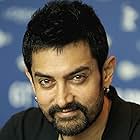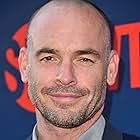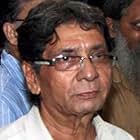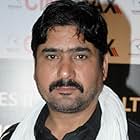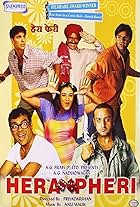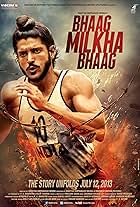IMDb RATING
8.1/10
123K
YOUR RATING
The people of a small village in Victorian India stake their future on a game of cricket against their ruthless British rulers.The people of a small village in Victorian India stake their future on a game of cricket against their ruthless British rulers.The people of a small village in Victorian India stake their future on a game of cricket against their ruthless British rulers.
- Nominated for 1 Oscar
- 54 wins & 22 nominations total
Raghubir Yadav
- Bhura
- (as Raghuveer Yadav)
Shri Vallabh Vyas
- Ishwar
- (as Sri Vallabh Vyas)
Javed Khan Amrohi
- Ram Singh
- (as Javed Khan)
Dayashankar Pandey
- Goli
- (as Daya Shankar Pandey)
Storyline
Did you know
- TriviaThe first cut of the film was 7 hours and 30 minutes long.
- GoofsWhen they get to the last over, someone says they need 10 runs off 6 balls - but in those days there would have been 4 or 5 balls to an over.
- Quotes
[Gauri is walking away in tears, Bhuvan shouts after her]
Bhuvan: Hey Gauri! There's only one house in the village with a neem tree in the yard. There's also a big field beside it. There's some chickens, two cows, and three goats. And I know whose house that is! It's mine, you silly girl! One thing before you go. Mother likes you, too!
- ConnectionsFeatured in The 74th Annual Academy Awards (2002)
- SoundtracksGhanan Ghanan
Music by A.R. Rahman
Lyrics by Javed Akhtar
Performed by Udit Narayan, Alka Yagnik, Sukhwinder Singh, Shankar Mahadevan,
Kishori Gowariker, Shaan and chorus
Featured review
Sony Entertainment's Lagaan is more an experience than a movie.
Indian actor Aamir Khan's home production is a cinematic experience which highlights Indian cinema to the hilt, while weaving a tale set in Champaner during the time of the British Empire's presence which deals with Lagaan (the tax of the land) and a village's upheaval against its oppressors.
The film revolves mainly around three characters namely Bhuvan (Aamir Khan), Gauri (debutante Gracey Singh) and Elizabeth (British actress Rachel Shelley), and deals with Bhuvan's spirited fight to defend what is his birthright, as he embroils the entire village into a magnitude of problems which inadvertently ends up being their only escape from the tyranny under which they reside. Gauri is the simple village girl who loyally stands behind the man she loves yet cannot profess her love to, while Elizabeth is the beautiful sister of the British Lieutenant and the complication who aids the village in their fight against injustice.
The first half sets the scene beautifully, explaining what Lagaan is, introducing the characters and gradually pulling the audience into this period and place, literally taking the viewer into Champaner through cinematography which highlights the locales and sets which establish the standard of living. It makes you feel for the characters, believe in the villagers and draws you into the celluloid created world, while the second presents to you their turmoil, dawns on you what is at stake and whisks you away in a tornado of emotions and rising spirits.
The opening scenes are more congruent to joining a conversation midway, as from the moment you are thrust into 1893's India, you gain footing and a sense of atmosphere, feeling at ease as the camera pans across its setting for the movie, drifting into the journey that will hold your attention for the duration of the film. Apart from familiarising the viewer with its characters, the first half also takes you back with its breathtakingly beautiful cinematography and fitting background score. The characters are established, the situation presented and relationships etched, with each scene rhythmically flowing from one to the other in a continuos motion.
The second half is less involved in justifying its characters and aims more towards culminating the scene which has been set in the first. By this time you are already a part of this world and your emotions have already been stirred, now they are put to the test as the events which will determine the entire crux of the film begin and get the viewer involved.
The romantic triangle between Bhuvan, Gauri and Elizabeth is expertly handled. The beauty of its predicament is that no one feels a loss by the end of the film, and director Ashutosh Gowariker beautifully justifies eternal love (but not necessarily requitted love) through drawing a comparison with the spiritual romance of the Hindu god Krishna and Radha. A delightfully delicately handled scene and situation gives birth to the foundation which will resolve the triangle in a manner leaving warmth in the viewer's heart.
Aamir Khan is a revelation. His acting is superb and be it the conviction and fire in his eyes, the way he draws breaths from the air of the abode he calls home or even gulps at the atrocities he witnesses, he has become Bhuvan completely. His portrayal is such that it puts you inside Bhuvan's psyche and enables the viewer to understand the character from his demeanour alone. His piercing eyes stare sharply like razor blades, cutting through the camera and leave a haunting impression on an unsuspecting audience, drawing them more and more deeper into his world.
Gracey Singh performs ably and is also an extremely graceful dancer, as particularly evident in the Radha Kaise Na Jale song. She acts with her eyes, eyebrows, nose, mouth, all of her and gives to the role of Gauri completely, giving a debut performance of high calibre.
Rachel Shelley makes her presence felt like an ethereal spirit. Apart from looking stunning she adds to whichever frame she is in with panache and style. Her crossover to Indian cinema, or indeed to this film, is delicately handled and a feat to be applauded. To light a face like Shelley's in the same frame as the villagers without making one or the other look considerably darker or awkwardly paler, is a difficult task in itself. But the cinematography, the lighting and make up is such that the characters come alive as physical presences which complement each other, as do Aamir Khan and Rachel Shelley. Her interactions with Bhuvan and the villagers are intricately handled and executed wonderfully, and her inclusion in the O Rey Chori song is poetry on screen. To make a Western character dance in Indian cinema without causing a giggle from the audience or without it appearing unnatural is also something which needs to be handled with careful thought and the result is such that this song picturisation alone will invoke discussion on how beautifully it has been shot.
Andrew Russell's boisterous character is brought to life by Paul Blackthorne, as he slides perfectly under the skin of a character that should reflect British pride and be menacing and hostile. He performs well and bounces off the supporting cast with utmost ease. The entire ensemble of supporting cast are deserved of mention, and particularly Raghuveer Yadav, who dynamically brings the character of Bhura across effectively and convincingly with edge.
A R Rahman is the composer who has scored for many Indian and South Indian films, and this time too he does not betray his reputation of being a modern day Mozart. He literally teases then grabs you with his music, first resonating your veins, then breaths and finally allowing it to explode and burst through your body like an energy force, flowing in sync with your heartbeat. It's lilting melody, fresh sound and courageous allegros mesmerise and reflect the movie's emotions and spirit of hope. The songs are very well picturised and choreography is excellent, particularly Ghanan Ghanan, O Mitwa and O Rey Chori. The bhajan O Paalanhaare is bewitchingly lit and shot, injecting a spiritual vibe as candles' flickering flames hypnotise every viewer whose eyes dance to its command.
The film belongs to Aamir and Ashutosh Gowariker all the way. Direction is superb and results in what is a true mark on Indian cinema, held together by Aamir's awe-inspiring performance.
Lagaan is about hope, courage, fighting against injustice, the human spirit and about Indians. You enter the cinema to be entertained, and leave with a piece of cinematic history being firmly etched in your heart.
Fuad Omar.
Indian actor Aamir Khan's home production is a cinematic experience which highlights Indian cinema to the hilt, while weaving a tale set in Champaner during the time of the British Empire's presence which deals with Lagaan (the tax of the land) and a village's upheaval against its oppressors.
The film revolves mainly around three characters namely Bhuvan (Aamir Khan), Gauri (debutante Gracey Singh) and Elizabeth (British actress Rachel Shelley), and deals with Bhuvan's spirited fight to defend what is his birthright, as he embroils the entire village into a magnitude of problems which inadvertently ends up being their only escape from the tyranny under which they reside. Gauri is the simple village girl who loyally stands behind the man she loves yet cannot profess her love to, while Elizabeth is the beautiful sister of the British Lieutenant and the complication who aids the village in their fight against injustice.
The first half sets the scene beautifully, explaining what Lagaan is, introducing the characters and gradually pulling the audience into this period and place, literally taking the viewer into Champaner through cinematography which highlights the locales and sets which establish the standard of living. It makes you feel for the characters, believe in the villagers and draws you into the celluloid created world, while the second presents to you their turmoil, dawns on you what is at stake and whisks you away in a tornado of emotions and rising spirits.
The opening scenes are more congruent to joining a conversation midway, as from the moment you are thrust into 1893's India, you gain footing and a sense of atmosphere, feeling at ease as the camera pans across its setting for the movie, drifting into the journey that will hold your attention for the duration of the film. Apart from familiarising the viewer with its characters, the first half also takes you back with its breathtakingly beautiful cinematography and fitting background score. The characters are established, the situation presented and relationships etched, with each scene rhythmically flowing from one to the other in a continuos motion.
The second half is less involved in justifying its characters and aims more towards culminating the scene which has been set in the first. By this time you are already a part of this world and your emotions have already been stirred, now they are put to the test as the events which will determine the entire crux of the film begin and get the viewer involved.
The romantic triangle between Bhuvan, Gauri and Elizabeth is expertly handled. The beauty of its predicament is that no one feels a loss by the end of the film, and director Ashutosh Gowariker beautifully justifies eternal love (but not necessarily requitted love) through drawing a comparison with the spiritual romance of the Hindu god Krishna and Radha. A delightfully delicately handled scene and situation gives birth to the foundation which will resolve the triangle in a manner leaving warmth in the viewer's heart.
Aamir Khan is a revelation. His acting is superb and be it the conviction and fire in his eyes, the way he draws breaths from the air of the abode he calls home or even gulps at the atrocities he witnesses, he has become Bhuvan completely. His portrayal is such that it puts you inside Bhuvan's psyche and enables the viewer to understand the character from his demeanour alone. His piercing eyes stare sharply like razor blades, cutting through the camera and leave a haunting impression on an unsuspecting audience, drawing them more and more deeper into his world.
Gracey Singh performs ably and is also an extremely graceful dancer, as particularly evident in the Radha Kaise Na Jale song. She acts with her eyes, eyebrows, nose, mouth, all of her and gives to the role of Gauri completely, giving a debut performance of high calibre.
Rachel Shelley makes her presence felt like an ethereal spirit. Apart from looking stunning she adds to whichever frame she is in with panache and style. Her crossover to Indian cinema, or indeed to this film, is delicately handled and a feat to be applauded. To light a face like Shelley's in the same frame as the villagers without making one or the other look considerably darker or awkwardly paler, is a difficult task in itself. But the cinematography, the lighting and make up is such that the characters come alive as physical presences which complement each other, as do Aamir Khan and Rachel Shelley. Her interactions with Bhuvan and the villagers are intricately handled and executed wonderfully, and her inclusion in the O Rey Chori song is poetry on screen. To make a Western character dance in Indian cinema without causing a giggle from the audience or without it appearing unnatural is also something which needs to be handled with careful thought and the result is such that this song picturisation alone will invoke discussion on how beautifully it has been shot.
Andrew Russell's boisterous character is brought to life by Paul Blackthorne, as he slides perfectly under the skin of a character that should reflect British pride and be menacing and hostile. He performs well and bounces off the supporting cast with utmost ease. The entire ensemble of supporting cast are deserved of mention, and particularly Raghuveer Yadav, who dynamically brings the character of Bhura across effectively and convincingly with edge.
A R Rahman is the composer who has scored for many Indian and South Indian films, and this time too he does not betray his reputation of being a modern day Mozart. He literally teases then grabs you with his music, first resonating your veins, then breaths and finally allowing it to explode and burst through your body like an energy force, flowing in sync with your heartbeat. It's lilting melody, fresh sound and courageous allegros mesmerise and reflect the movie's emotions and spirit of hope. The songs are very well picturised and choreography is excellent, particularly Ghanan Ghanan, O Mitwa and O Rey Chori. The bhajan O Paalanhaare is bewitchingly lit and shot, injecting a spiritual vibe as candles' flickering flames hypnotise every viewer whose eyes dance to its command.
The film belongs to Aamir and Ashutosh Gowariker all the way. Direction is superb and results in what is a true mark on Indian cinema, held together by Aamir's awe-inspiring performance.
Lagaan is about hope, courage, fighting against injustice, the human spirit and about Indians. You enter the cinema to be entertained, and leave with a piece of cinematic history being firmly etched in your heart.
Fuad Omar.
- How long is Lagaan: Once Upon a Time in India?Powered by Alexa
Details
- Release date
- Countries of origin
- Languages
- Also known as
- Taxation: Once Upon a Time in India
- Filming locations
- Production companies
- See more company credits at IMDbPro
Box office
- Budget
- ₹250,000,000 (estimated)
- Gross US & Canada
- $909,043
- Opening weekend US & Canada
- $285,368
- Jun 17, 2001
- Gross worldwide
- $1,724,806
- Runtime3 hours 44 minutes
- Color
- Sound mix
- Aspect ratio
- 2.35 : 1
Contribute to this page
Suggest an edit or add missing content

Top Gap
What is the streaming release date of Lagaan: Once Upon a Time in India (2001) in Australia?
Answer














